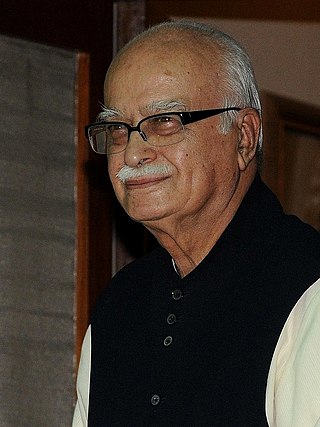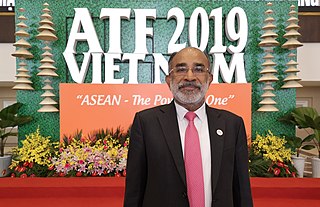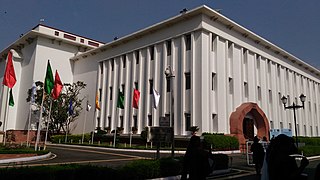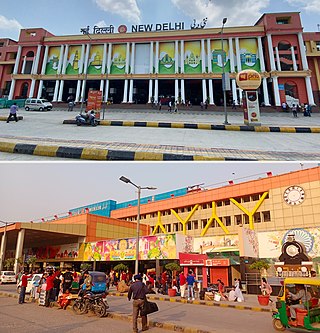
The prime minister of India is the head of government of the Republic of India. Executive authority is vested in the prime minister and his chosen Council of Ministers, despite the president of India being the nominal head of the executive. The prime minister is often the leader of the party or the coalition with a majority in the lower house of the Parliament of India, the Lok Sabha, which is the main legislative body in the Republic of India. The prime minister and their cabinet are at all times responsible to the Lok Sabha.

Lal Krishna Advani is an Indian politician who served as the 7th Deputy Prime Minister of India from 2002 to 2004. Advani is one of the co-founders and a senior leader of the Bharatiya Janata Party. He is a long time member of the Rashtriya Swayamsevak Sangh, a volunteer organisation. He is also the longest serving Minister of Home Affairs in the BJP-led National Democratic Alliance government from 1998 to 2004. He was the Leader of the Opposition in the 10th Lok Sabha and 14th Lok Sabha and also the longest serving person of this post. He was the Prime Ministerial candidate of BJP in 2009.

Agra is a city on the banks of the Yamuna river in the Indian state of Uttar Pradesh, about 230 kilometres (140 mi) south-east of the national capital Delhi and 330 km west of the state capital Lucknow. With a population of roughly 1.6 million, Agra is the fourth-most populous city in Uttar Pradesh and twenty-third most populous city in India.

The Parliament of India is the supreme legislative body of the Republic of India. It is a bicameral legislature composed of the Rajya Sabha and the Lok Sabha. The President of India, in their role as head of the legislature, has full powers to summon and prorogue either house of Parliament or to dissolve the Lok Sabha. The president can exercise these powers only upon the advice of the Prime Minister and their Union Council of Ministers.
The Government of India, also known as the Union Government or Central Government but often simply as the Centre, is the national authority of the Republic of India, a federal democracy located in South Asia, consisting of 28 union states and eight union territories.

Fakhruddin Ali Ahmed was an Indian lawyer and politician who served as the fifth president of India from 1974 to 1977.

Neelam Sanjiva Reddy was an Indian politician who served as the sixth president of India, serving from 1977 to 1982. Beginning a long political career with the Indian National Congress Party in the independence movement, he went on to hold several key offices in independent India — as Deputy Chief minister of Andhra state and the first Chief Minister of United Andhra Pradesh, a two-time Speaker of the Lok Sabha and a Union Minister— before becoming the Indian president.

Chanakyapuri is a neighbourhood and diplomatic enclave established in the 1950s in New Delhi. It is also a sub-division of the New Delhi district and plays host to the majority of foreign embassies in New Delhi. Chanakyapuri, meaning "city of Chanakya", is named after Chanakya, an ancient Indian philosopher, politician, military strategist and advisor to emperor Chandragupta Maurya.

Lodhi Road in New Delhi, India, is named after the Lodhi Gardens located on it. Two Mughal mausoleums, Humayun's Tomb and Safdarjung's Tomb, lie at the eastern and western ends of the road respectively. A number of cultural, educational, and international institutions line the road. The Jor Bagh metro station lies under Aurobindo Marg near its intersection with Lodhi Road. Also located near it are Lodhi colony and Lodhi Estate built during British Raj in 1940s, and Lodhi Road Institutional Area.

Sushma Swaraj was an Indian lawyer, politician, and diplomat who served as the Minister of External Affairs of India in the first Narendra Modi government from 2014 to 2019. She was the second person to complete a 5-year term as the Minister of External Affairs, after Jawaharlal Nehru. A senior leader of the Bharatiya Janata Party (BJP), Swaraj was the second woman to hold the office of Minister of External Affairs, after Indira Gandhi. She was elected seven times as a Member of Parliament and three times as a Member of the Legislative Assembly. At the age of 25 in 1977, she became the youngest cabinet minister of the Indian state of Haryana. She also served as 5th Chief Minister of Delhi for a short duration in 1998 and became the first female Chief Minister of Delhi.

Jagmohan Malhotra, known by the mononym Jagmohan, was an Indian civil servant and politician. After working with the Indian National Congress, he joined the Bharatiya Janata Party in 1995. He served as Lieutenant Governor of Delhi and Goa, as the 5th Governor of Jammu and Kashmir, and for three terms as Member of Parliament for New Delhi. In the cabinet, he served as Union Minister for Urban Development and Tourism.

Lutyens' Delhi is an area in New Delhi, India, named after the British architect Sir Edwin Lutyens (1869–1944), who was responsible for much of the architectural design and building during the period of the British Raj, when India was part of the British Empire in the 1920s and 1930s and 1940s. This also includes the Lutyens Bungalow Zone (LBZ).

The India Tourism Development Corporation (ITDC) is a hospitality, retail and education company owned by the Government of India, under the administration of the Ministry of Tourism. Established in 1966, it owns over 17 properties under the Ashok Group of Hotels brand, across India.

Alphons Joseph Kannanthanam or K. J. Alphons is an Indian civil servant, advocate, and politician from Kerala. He is the former Union Minister of State for Culture, and Tourism, in office since 3 September 2017 to May 2019 under the B.J.P. Government of Narendra Modi, MP.

Vigyan Bhawan is a premier conference centre of the Government of India in New Delhi. Built in 1956, over the years it has been the venue of conferences of national and international stature, seminars and award ceremonies attended by distinguished world leaders and dignitaries, including Commonwealth Heads of Government Meeting (CHOGM) in 1983, 7th Summit of the Non-Aligned Movement (NAM), March 7–12, 1983, and SAARC Summit. It is managed by the Directorate of Estates, under the Ministry of Urban Development, Government of India, and maintained by CPWD.
Sambit Patra is an Indian politician and has served as the National spokesperson of the Bharatiya Janata Party since 2014 and currently serving as a chairman in tourism department. Patra had his first job at Hindu Rao Hospital. He was appointed an independent director of the board of Oil and Natural Gas Corporation Limited (ONGC) in 2017. On 30 November 2021, Patra was appointed Chairman of the India Tourism Development Corporation.

New Delhi railway station is the main railway station in the Indian capital of New Delhi. Platform 1 is located at Paharganj and platform 16 opens up on to the side of Ajmeri Gate. The station is about two kilometres (1.2 mi) north of Connaught Place in central New Delhi. It is one of the busiest railway stations in the country in terms of train frequency and passenger movement.

Lala Achint Ram was an Indian freedom fighter, Gandhian and a member of the Indian National Congress party.
Shiv Nath Prasad was an Indian architect and urban planner known for his Brutalist architecture designs. He was also called the "Le Corbusier of India".

















